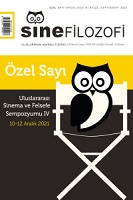“YouTube’da Nietzsche Üzerine Bir Kısa Film İzledim”: Dijital Karşılaşmalar Çağında Sinema Deneyimi
“I Watched a Short Film about Nietzsche on YouTube”: Cinema Experience in the Age of Digital Encounters
Author(s): Sinan Vardar, Harun M. TöleSubject(s): Media studies, Aesthetics, 19th Century Philosophy, Film / Cinema / Cinematography, Sociology of Art
Published by: Serdar Öztürk
Keywords: Cinema; short film; social media; digital encounters;
Summary/Abstract: Internet and internet-based applications have now become a part of our daily lives. Within the framework of this technological life we have experienced, our watching habits have also undergone a transformation. Today, digital encounters that we experience in internet-based social media and video sharing platforms, whether as academic or leisure activities, also shape our relationship with movies. Our practices of watching movies, interpreting and sharing the information we have gained from these processes with the relevant people come into existence under the conditions of this digital environment. All these issues deeply affect all moviegoers in general and “cinephiles” in particular, which we can describe as passionate moviegoers. The activities and digital encounters of cinephiles, who consider thinking, talking and sharing about movies as a passion, are now being experienced in virtual environments such as social media, blogs and websites. This study is based on Fáuston da Silva’s short film Meu Amigo Nietzsche [My Friend Nietzsche] (2012), which is encountered when searching for “Nietzsche” on YouTube as part of an academic research. The protagonist of the movie, Lucas, embarks on a new adventure by meeting with thinkers he does not know in his relationship with Nietzsche’s book Also sprach Zarathustra [Thus Spoke Zarathustra] (1883), which he finds in the context of the randomness of life. This adventure of the little hero has similarities with our discovery of movie productions that appear on the screens of our devices connected to the internet, and our meeting with directors, cinemas, genres, heroes, stories and narratives that we have never met. From this point of view, the findings related to the problems of watching, participation, sharing, criticism and encountering the new generation cinematic experiences on platforms such as YouTube, which emerged with digitalization, are discussed through the approaches presented in the fields of philosophy, sociology, cinema, architecture, communication history and cultural studies. In this context, for the understand the habitat of the new cinephilia, we use the approaches which presented by Joseph Carl Robnett Licklader, Hubert L. Dreyfus, Marshall McLuhan, Sherry Turkle, Henry Jenkins, about interaction between the internet, virtual world and smart machines. We made benefit of approaches of David Lyon, Gary Marx, Shoshane Zuboff, Giovanni Sartori, Stefan Aust and Thomas Amman, in order to make sense of the history of electronic and digital surveillance systems that threaten the Internet’s free world, and the cyber policy. In order to understand the culture of cinephilia, new cinephilia and the history of the transformed cinematic experience, we included the approaches of Siegfried Kracauer, Susan Sontag, Girish Shambu, André Gaudreault and Philippe Marion and discussed these approaches comparatively.
Journal: SineFilozofi
- Issue Year: 7/2022
- Issue No: Sp. Iss.
- Page Range: 184-210
- Page Count: 27
- Language: Turkish

